
Review Article
Austin Virol and Retrovirology. 2023; 5(1): 1028.
Epidemiology of Neuromuscular Manifestations in Patients Carrying the Hiv Virus in Brazil
Karina Lebeis Pires1*; Oswaldo JM Nascimento2; kai-Uwe Lewandrowski3; Max Ramos4*
1Professor of Neurology, Federal University of the State of Rio de Janeiro, Coordinator of the Rare Neuromuscular Diseases Ambulatory at HUGG, Brazil
2Full Professor of Neurology at the Fluminense Federal University, Brazil
3Professor Honoris Causa, Federal University of the State of Rio de Janeiro, Coordinator of the Spine Care Center and Surgery Institute of Tucson, Arizona, USA
4Full Professor and Head of Orthopedics, Federal University of the State of Rio de Janeiro, Brazil
*Corresponding author: Karina Lebeis Pires Professor of Neurology at the Federal University of the State of Rio de Janeiro and Coordinator of the Rare Neuromuscular Diseases Ambulatory at HUGG. Max Ramos, Full Professor and Head of Orthopedics at the Federal University of the State of Rio de Janeiro. Email: drmaxramos@hotmail.com, karinalebeis2@gmail.com
Received: July 26, 2023 Accepted: August 23, 2023 Published: August 30, 2023
Summary
The present study aims to present and discuss epidemiological aspects of the distribution of neurological signs and symptoms in HIV-positive patients treated with Anti Retro Viral ARV therapy in Brazil.
HIV infection has been challenging health authorities since the 1980s. In Brazil, 1,045,355 cases of Acquired Immunodeficiency Syndrome (AIDS) were identified from 1980 to June 2021. According to the Ministry of Health (MS), there has been a 35.7% reduction in the AIDS detection rate since 2012. Even so, 32,701 new cases were detected in 2 020. The most frequent neurological manifestations can be divided into: Inflammatory demyelinating polyradiculoneuropathy, Mononeuropathy and mononeuropathy multiplex, Radiculopathy, Myopathy and diseases of the neuromuscular junction,Motor neuron disease, HIV-associated sensory neuropathy, HIV-associated sensory neuropathy.
Many advances have been observed in recent years regarding the diagnosis and treatment of infection by this virus, however, it remains an important public health problem.
Keywords: HIV; Neuropathy; Epidemiology
Introduction
HIV infection has been challenging health authorities since the 1980. In Brazil, 1,045,355 cases of Acquired Immunodeficiency Syndrome (AIDS) were identified from 1980 to June 2021. According to the Ministry of Health (MS), there has been a 35.7% reduction in the AIDS detection rate since 2012. Even so, 32,701 new cases were detected in 2 020 (MINISTRY OF HEALTH., 2021) [1]. Many advances have been observed in recent years regarding the diagnosis and treatment of infection by this virus, however, this remains an important public health problem.
In 2014, with the inclusion of HIV infection in the list of notifiable diseases, there was a better understanding of the epidemiological profile, allowing the redirection of public health policies. In 2015, there was a 42.3% drop in mortality compared to 1995 (MINISTÉRIO DA SAÚDE., 2017). Of the cases notified until 2021, 43.3% were concentrated in the Southeast region, 69.8% in men, 52.9% in individuals aged between 20 and 34 years and 51.7% in black individuals. Of the cases reported in men, 52.1% were related to homosexual exposure, while in women, 86.8% were related to heterosexual exposure [1].
Among the systemic manifestations of HIV infection, neurological impairment has a great impact on morbidity and mortality. and it occurs not only in association with opportunistic diseases but also by direct action of the virus and exposure to Antiretrovirals (ARV). It is estimated that 40 to 70% of patients have both central and peripheral neurological manifestations (BOISSÉ; GILL; POWER, 2008). With the advent of combined Antiretroviral Therapy (ARTVC) there was a reduction in mortality, but the time of exposure to the virus and ARVs increased. Thus, there was a reduction in neurological impairment secondary to opportunistic infections related to states of severe immunosuppression. On the other hand, symptoms associated with the permanence of the virus and exposure to ART, such as peripheral neuropathy, remain the main neurological alterations (BOISSÉ; GILL; POWER, 2008; CHEN et al., 2013; MORGELLO et al., 2004a; PRIOR; SONG; COHEN, 2018 [2-5,7].
Sensory peripheral neuropathy, particularly Distal Symmetrical Polyneuropathy (DSP), has an incidence that varies between 30 and 67% of cases (KAKU; SIMPSON, 2014 [6] and PRIOR; SONG; COHEN, 20185). 012; KAKU; SIMPSON, 20145; THEMISTOCLEOUS et al., 2014 [8].
One of the pathophysiological explanations for peripheral nervous system impairment involves macrophage dysregulation. As a result, there is a release of pro-inflammatory cytokines and predominantly fiber damage. nervous thin (poorly myelinated Iorunmyelinated). The end result of this process is degeneration of distal axons and neuronal loss in the dorsal root ganglion [8].
Despite the still high numbers, the AIDS detection rate has been falling in Brazil in recent years. From 2012 to 2013 there was a decrease in the number of cases of 1.4%, from 2013 to 2014 3.6%, from 2014 to 2015 4.2% and from 2015 to 2016 the reduction was 5.2% (BOLETIM AIDS, 2017) [1].
Figure 1 below represents the identification rate of the number of cases in Brazil by region in 10 years.
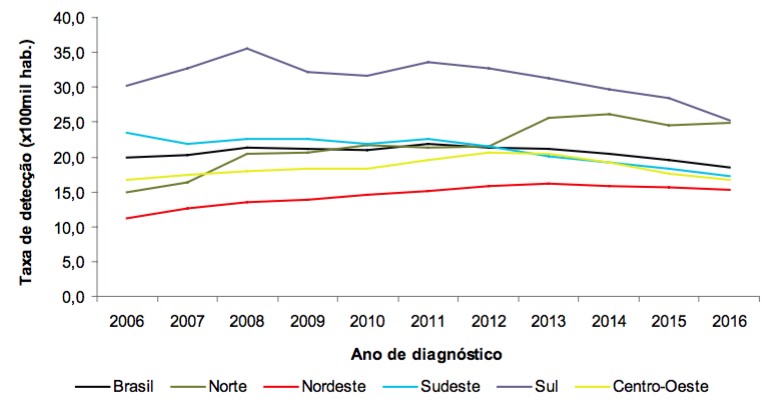
Figure 1: Detection rate of the number of cases by region of Brazil from 2006 to 2016.
Considering the distribution of cases between men and women, from 1980 to 2017, 576,245 (65.3%) cases were identified in men and 306,444 (34.7%) in women. The number of cases in men has increased in the last 10 years, corresponding to an increase rate of 7.1% from 2006 to 2016 (Figure 2). Already in womenthere was a reduction in the number of cases with a 27% reduction rate in the same period [1].
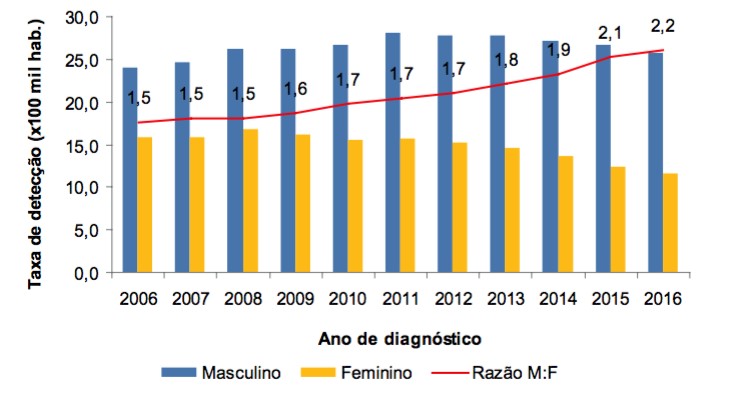
Figure 2: AIDS detection rate in relation to sex and sex ratio, by year, in Brazil from 2006 to 2016. (BOLETIM AIDS, 2017).
Regarding age group, the highest concentration of cases in both sexes is in individuals between 25 and 39 years old. In the last 10 years, there has been a reduction in the number of cases in children under 14 years of age, both in males and females. At other ages, the number of infected men is greater than women. A Figure 3 below represents the AIDS detection rate among men and women according to age group in the last 10 years.

Figure 3: AIDS detection rate by age group and sex in Brazil in 2006 and 2016.
In men, the greatest increase in the number of cases occurred between the ages of 15 to 19 years, 20 to 24 years, 25 to 29 years and over 60 years, with the most important increase being between 15 and 19 years. In this age group, the detection rate almost tripled from 2006 to 2016.
Among women there has been a reduction in the number of cases in recent years in virtually all age groups except between 15 to 19 years and over 60 years. In each of these two groups there was an increase of 13.9% and 14.3% respectively.
The main sources of HIV infection are vertical transmission, sexual transmission, injecting drug use and blood transfusion. Among individuals younger than 13 years, the main route of infection is vertical transmission, corresponding to 93.1% of cases. In people over 13 years of age, the main form of infection was sexual in both men and women, 95.8% and 97.1% respectively in 2016. Among men, there is a predominance of homosexual exposure.
Transmission among injecting drug users has been decreasing in recent years, representing 3.2% of cases in men and 1.9% of cases in women in 2016. What is observed in relation to race/color in the last 10 years was a reduction of 21.9% in the number of cases in whites and an increase of 35.7% in browns. Figure 4 below represents the distribution of the percentage of cases by race/color from 2006 to 2016 [1].
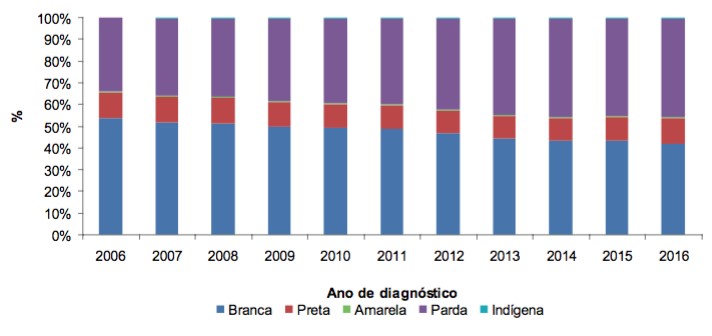
Figure 4: Percent distribution of AIDS cases according to race/skin color per year in Brazil from 2006 to 2016.
The number of cases also varies in relation to the level of education. The highest number of cases is found among individuals with the 5th to 8th grade (25.5%). Male individuals with AIDS have a higher level of education than females. The distribution of cases among illiterates and It is greater in women than in men (3.9% and 2.3% respectively). In patients with complete higher education, the proportion was 13.1% in men compared to 4.7% among women.
With the beginning of the treatment policy for all, there was a reduction in mortality of 7.2% from 2014 to 2015. In the period from 2006 to 2017, there was a reduction of 11.9%. Regarding the regions of Brazil, there was a decrease in the mortality rate in the Southeast, South and Midwest regions and an increase in the North and Northeast regions. Figure 5 shows the AIDS mortality rate by region in Brazil from 2006 to 2017 [1].
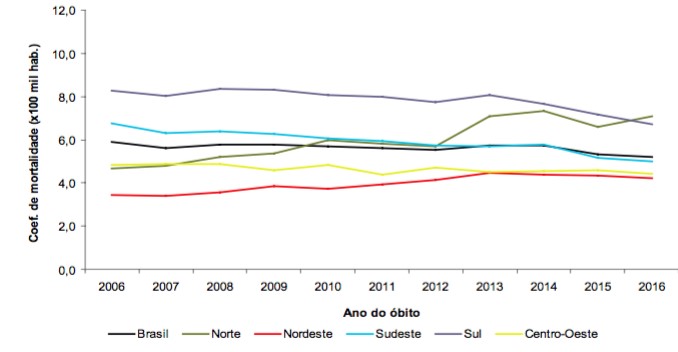
Figure 5: AIDS mortality coefficient by regions of Brazil from 2006 to 2016.
Despite the increase in the number of cases of patients infected with HIV, especially after the institution of compulsory notification in 2014, there is a tendency towards stabilization in the number of AIDS cases. This probably reflects the attention of health policies regarding this infection. In 2015, the Ministry of Health invested R$1.5 billion in HIV/AIDS prevention, care and control actions.
After the beginning of the post-ARTVC era, manifestations secondary to HIV and related to severe immunosuppression became less and less frequent, resulting in increased life expectancy. However, despite apparently being a positive point, this fact changed the medical approach towards HIV-infected patients. The increase in life expectancy and improvement in the immune profile has made these individuals at risk of diseases common in the general population, such as systemic arterial hypertension, diabetes, obesity, among others (PRIOR, SONG and COHEN, 2018). In addition, there was an increase in the time of infection, representing a longer period of exposure to HIV and the toxic effects of ART. All these factors, as they are major “villains” of the SNP, HIV-associated neuromuscular disorders can occur at any stage of HIV infection. The pathophysiology of this involvement involves the presence of the HIV virus, immune dysregulation, associated comorbidities, the toxic effects of antiretroviral therapy, in addition to the patient's genetic susceptibility (PRIOR, SONG and COHEN, 2018 [5].
a) Inflammatory Demyelinating Polyradiculoneuropathy
Acute Inflammatory Demyelinating Polyradiculoneuropathy (AIDP) and chronic Inflammatory Demyelinating Polyradiculoneuropathy (CIDP) are autoimmune processes against the myelin sheath resulting in demyelination of multiple areas of the peripheral nervous system. They are rare forms of neurological manifestation in HIV positive patients AIDP can occur in the early phase of the infection while CIDP manifests itself in any phase of the disease
Despite presenting clinically in a similar way in HIV-positive patients and in the general population, they have a peculiar evolution in the first group. Individuals infected with HIV and with AIDP tend to evolve more quickly (in a few days) than 2 weeks, as is the most classic case in the general population. In addition, they may have a higher risk of recurrence of acute episodes and a greater chance of evolving to the chronic form., SÈNE, 2018 [9].
CIDP in HIV-positive patients, on the other hand, has a monophasic evolution and with better response to corticosteroids than in individuals not infected by this virus. Both the acute and chronic forms affect younger individuals when there is an association with HIV. This is probably due to the epidemiology of this retrovirus infection.
The incidence is unknown and the pathogenesis in this group of patients is complex and not well understood, but it is believed that HIV acts as a trigger for autoimmune dysregulation, in addition, opportunistic diseases, such as CMV infection, can also alter the immune response against self-antigens [5].
The diagnosis of CIDP and AIDP is made in the same way as for the general population. Clinical manifestations such as symmetrical paresis, hyporeflexia and altered sensitivity, demyelinating characteristics on ENMG and examination of Cerebrospinal Fluid (CSF) lead to the diagnosis, but pleocytosis and higher protein levels occur in the CSF than in patients not infected with HIV, which can be explained by the BHN disruption that occurs in the pathophysiology of HIV infection. Nerve biopsy, when necessary, may show onion bulb formations. These formations are characterized by concentric layers of Schwann cells surrounding a demyelinated and subsequently remyelinated axon (ROBINSON-PAPP and SIMPSON, 2009). Figure 6 demonstrates onion bulb formation in an electron micrograph of a peripheral nerve biopsy in an HIV-positive patient with CIDP. Magnetic Resonance Imaging (MRI) of the spinal cord with or without gadolinium can be performed to exclude differential diagnoses such as infiltrative masses but can show enhancement of nerve roots in polyradiculoneuropathies.
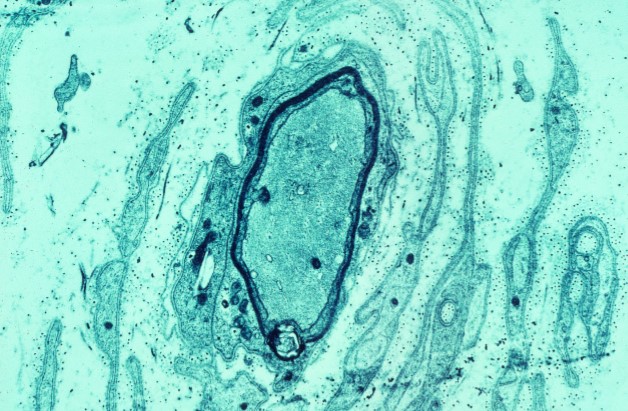
Figure 6: Onion bulb formation in electron micrograph of peripheral nerve biopsy in an HIV-positive patient with CIDP.
The treatment of acute and chronic forms of demyelinating polyradiculoneuropathy can be done with human immunoglobulin or plasmapheresis. According to MOODLEY, BILL and PATEL 2016, who comparatively studied CIDP in HIV-infected and non-infected patients, HIV-positive patients respond better to treatment with corticosteroids than the general population. Therefore, as the use of corticosteroids is associated with lower cost, it is suggested that it should be tried before opting for immunoglobulin or plasmapheresis PATEL, 2016 [11].
b) Mononeuropathy and Multiple Mononeuropathy
Mononeuropathies are rare manifestations of HIV infection, and may occur in the early stages of the disease or in more advanced stages, and may affect peripheral or cranial nerves. HIV infection may predispose to compression-susceptible neuropathy. Uni or bilateral peripheral facial paralysis may occur in the acute phase of the disease. Some opportunistic infections such as Varicella Zoster Infection (VZV) and others that co-occur with meningitis such as tuberculosis, syphilis and cryptococcosis can lead to the involvement of multiple cranial nerves. Another disease that can manifest itself in the same way is meningeal lymphomatosis [5].
The treatment of mononeuropathies in HIV-positive patients is done in a similar way to that of patients not infected by this virus. The only reservation is made in relation to Acyclovir, which has its controversial use in immunocompetent patients, but is used associated with corticosteroids in patients with HIV infection due to the possibility of co-infection with VZV.
Multiple mononeuropathies are also rare manifestations. They can occur in the initial phase, due to immunological processes secondary to seroconversion, or in advanced stages of the disease. These cases usually occur due to vasculitis caused by deposits of immune complexes resulting from HIV infection. or coinfection with hepatitis B and C viruses. Figure 7 shows sural nerve biopsy of an HIV-positive patient with mononeuropathy multiplex secondary to necrotizing vasculitis. In immunosuppressed patients or in areas where access to ARVs is not widespread, mononeuropathy multiplex occurs as a result of opportunistic infections such as Cytomegalovirus (CMV), Herpes Simplex Virus (HSV) and VZV [5,6].
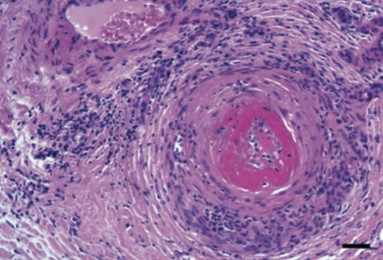
Figure 7: Sural nerve biopsy of an HIV-positive patient with mononeuropathy multiplex secondary to necrotizing vasculitis. Hematoxylin-eosin staining.
Clinically patients present with painful polyneuropathy affecting multiple nerves asymmetrically, progressively affecting each nerve. The impairment is progressive and may be manifested in a sensory, motor or autonomic way.
The diagnosis should include a detailed neurological examination with the presence of neuropathy affecting multiple nerves asymmetrically, ENMG with evidence of multifocal neuropathy, often axonal in nature, electromyography with signs of denervation and, in selected cases, nerve biopsy. Although this is not mandatory in all cases, it may be important in patients with suspected co-infection, guiding the best treatment. Biopsy may show epineural and endoneurial perivascular inflammatory infiltrate. For etiological complementation, serology for hepatitis B and C in the blood and research by Polymerase Chain Reaction (PCR) must be requested in all patients. Polymerase chain reaction for CMV in the CSF. In case of positivity for CMV infection, treatment with Ganciclovir should be instituted [8]. CSF PCR negativity for CMV does not exclude infection by this virus, since it can only be found in the peripheral nerve, a situation in which nerve biopsy becomes useful. In patients with a CD4 count of less than 200 cells/mm3, CMV infection should be suspected, especially if there are signs of involvement by this virus in other organs such as the retina and gastrointestinal tract. Mononeuropathy multiplex in an HIV-positive patient with CMV infection is more rapidly progressive, affecting a greater number of nerves and with a worse chance of recovery when compared to patients who do not have evidence of CMV (ROBINSON-PAPP and SIMPSON, 2009). In case of HIV-only mononeuropathy multiplex, symptoms are mild and may regress within months. If there is no evidence of CMV infection and improvement of symptoms, treatment can be performed with venous immunoglobulin, plasmapheresis [6-9].
c) Radiculopathy
HIV positive patients with advanced immunosuppressioncan present can manifestwith polyradiculopathy. This involvement results from inflammation and necrosis of nerve roots. It is usually caused by opportunistic infections such as CMV but also by other agents such as HSV, VZV, Treponema pallidum, Mycobacterium tuberculosis and lymphomatosis. In the pre-ARTVC era, CMV was the main cause of polyradiculopathy, especially in patients with a CD4 count of less than 50 cells/mm3 [4].
Symptoms begin with subacute radicular pain that rapidly progresses to cauda equina syndrome. Symptoms are progressive of paresis, paresthesia, areflexia of the lower limbs associated with urinary and fecal sphincter alteration and anesthesia of the perineal region, known as saddle anesthesia. Compromise of upper limbs and cranial nerves may occur in more advanced cases.
Early diagnosis prevents limiting sequelae resulting from irreversible nerve root necrosis and should be performed by neurological examination with the above characteristics, lumbar puncture, ENMG and MRI. CSF examination may show neurotrophic pleocytosis, elevated protein with normal or slightly reduced glucose. CSF analysis should include search for other etiological agents for radiculopathy such as CMV, HSV and VZV by PCR technique. Electromyography can reveal signs of denervation at various radicular levels through evaluation of the paravertebral musculature with neuroconduction examination demonstrating axonal damage (PRIOR, SONG and COHEN, 2018). Spinal MRI may be normal or show gadolinium enhancement of the roots, which is also important to exclude differential diagnoses [1].
Drug treatment should not be delayed until confirmatory tests are ready. Ganciclovir should be started as CMV is the main cause, and polyradiculitis caused by this virus can be fatal [8].
d) Myopathy and Diseases of the Neuromuscular Junction
Myopathy, in the context of HIV infection, can occur at any stage of the disease, ranging from mild involvement torhabdomyolysis. The degree of involvement will depend on the patient's immunosuppression status. Prevalence is approximately 25%. Myalgias and asymptomatic elevation of Creatine Kinase (CK) may occur during seroconversion. Individuals using ART with Zidovudine may experience inflammatory myopathy and, in advanced stages of immunosuppression, myopathy secondary to opportunistic infections may occur. Therefore, the etiology is varied and may be related to direct HIV toxicity, uncontrolled immune response resulting in inflammatory myopathy similar to polymyositis, ARV toxicity and opportunistic infections [12].
Zidovudine, a Nucleoside Analogue Reverse Transcriptase Inhibitor (NRTI), is the main ART associated with the development of myopathy. This involvement is believed to occur due to mitochondrial Deoxyribonucleic Acid (DNA) depletion, oxidative stress, inhibition of mitochondrial functioning, L-carnitine depletion and apoptosis associated with its use. The treatment is done with the suspension of the use of Zidovudine. The use of carnitine 1500mg orally twice a day can prevent the development of Zidovudine-associated myopathy and reduce the progression to necrosis when there are already signs of myopathic involvement [12].
The main form of presentation is HIV-associated myopathy in which there is symmetrical and slowly progressive proximal paresis, increased Creatine Kinase (CK), myopathic findings on ENMG and pink cytoplasmic bodies on muscle biopsy with hematoxylin-eosin staining (Figure 8).
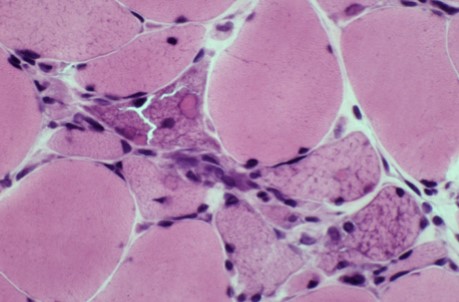
Figure 8: Muscle biopsy of an HIV-positive patient with proximal paresis demonstrating basophilic infiltrate and pink cytoplasmic bodies.
Inclusion body myositis is a rare manifestation in HIV-positive patients, where T cells have the function of repairing muscle fiber damage. Thus, the deregulation of T cells, as occurs in HIV infection, may cause less efficiency in repairing these damages, in addition to greater perpetuation of the inflammatory process resulting from the injury to the muscle fiber. Facial and cervical musculature may also be compromised. Treatment with human immunoglobulin may improve symptoms [5].
Another rare form of neuromuscular manifestation is nemaline myopathy. In this case, the immune response against HIV results in the deposition of rod-like structures (called nemaline bodies) and disruption of the Z lines of the muscle fiber. At MRI, edema and fat replacement can be seen affecting the proximal muscles of the upper and lower limbs. Muscle biopsy may demonstrate nemaline deposits. Treatment can be performed with corticosteroids in pulse therapy [13].
Myasthenic syndrome can also occur as a result of HIV infection. Immune dysregulation can result in the formation of antibodies against neuromuscular junction structures. The form of presentation is similar to the general population, with proximal paresis, palpebral ptosis, dysphagia, dysphonia and diplopia, but antibodies against the acetylcholine receptor may be low or absent. The diagnosis is then made by ENMG with repetitive stimulation and a positive response to pyridostigmine. Treatment should continue with venous immunoglobulin, prednisone or cyclophosphamide.
Patients presenting with constitutional symptoms, subacute onset symmetrical proximal paresis may have immune-mediated inflammatory myopathy. The inflammatory mechanism stems from the dysregulation of T cells resulting from HIV infection. Biochemistry may show an increase in CK and treatment can be performed with corticosteroids, azathioprine, methotrexate, cyclophosphamide, cyclosporine and human immunoglobulin [7].
Infectious myopathy or pyomyositis can occur in advanced stages of HIV infection. The main causative agent is Staphylococcus aureus, but other agents such as Toxoplasma, Cryptococcus and Mycobacterium avium have also been reported (ROBINSON-PAPP and SIMPSON, 2009). Patients may present with focal or multifocal pain, muscle swelling, fever, and sepsis. MRI and contrast-enhanced Computed Tomography (CT) and muscle ultrasonography can help in the etiological differentiation of myopathy, as abscesses can be seen in infectious causes [10].
Given these forms of presentation, HIV-positive patients who manifest myopathic symptoms should be investigated by means of biochemical collection, ENMG and, in some cases, muscle biopsy may be necessary. In biochemistry, CK, aldolase, aspartate aminotransferase, alanine aminotransferase and lactic dehydrogenase should be requested. These can be increased in all forms of presentations.
ENMG may show fibrillation, a positive wave, increased insertion activity, early recruitment, and low-amplitude, polyphasic, short-duration motor unit action potentials.
Muscle biopsy may demonstrate characteristic findings in nemaline myopathy, inclusion body myositis, and zidovudine-associated myopathy. In nemaline myopathy, muscle biopsy may show necrosis, inflammation, and red-blue cytoplasmic structures seen on Trichrome Gomori staining. In inclusion body myositis, red annular vacuoles, endomysial infiltrate of CD8+ T cells and macrophages, atrophic fibers and amyloid deposits are seen. Zidovudine-associated myopathy may show torn red fibers, cytochrome C oxidase-negative fibers, accumulation oflipids and glycogen, inflammatory infiltrate and reduced number of mitochondria [4-6].
e) Motor Neuron Disease
Motor Neuron Disease (MND) in HIV-positive patients manifests similarly to the general population and has an incidence of 3.5 cases/1000 patients versus 1 to 2 cases/100,000 per year in individuals not infected with this virus (PRIOR, SONG and COHEN, 2018). Paresis and asymmetric distal atrophy of the limbs, fasciculation, heightened deep reflexes and weight loss mayoccur, as well as trunk signs such as dysphagia, dyspnea and speech alteration. Some characteristics are related to a better prognosis, such as onset at a younger age and evolution in days to weeks. On the other hand, those who have an undetectable viral load at the onset of NMD manifestations have little or no responses.
Compared to the general population, NMD in HIV-positive individuals occurs at a younger age, in general before 40 years of age, presents rapid progression but may partially or completely improve after initiation of ART with drugs that penetrate the CNS. The good therapeutic response with the initiation of ARV treatment suggests a causal relationship between HIV and motor neuron disease.
The pathophysiology of NMD in HIV-infected patients is not well understood. CHERRY et al., 2005, suggest that the mechanism is related to the activation of a retrovirus called Human Endogenous Retrovirus K (HERV-K), in the cortex and anterior cord of the medulla, by HIV proteins. It has been previously described in the literature that in sporadic cases of NMD, there is activation of HERV-K in cortical neurons and anterior horn cells of the medulla.15 Studies involving neuron cultures from experimental animals have shown that activated HERV-K causes degeneration of motor neurons, resulting in symptoms similar to those of NMD. Studies carried out by JOHNSON et al., 2013 demonstrated that the HIV-Tat protein is capable of activating HERV-K and this protein has already been isolated in the brain of HIV-infected individuals.
Regarding the diagnosis, initially, ENMG of the four limbs and paravertebral musculature should be performed. This may demonstrate reduced motor action potential amplitude, fasciculation, fibrillation and positive waves (signs of active denervation) and reduced motor units when assessing recruitment. Clinically, it may be difficult to rule out that upper motor neuron signs are not myelopathy or that second neuron signs are not neuropathy or radiculopathy.
f) Other neuromuscular manifestations
Autonomic symptoms such as dry mouth, postprandial fullness, orthostatic hypotension, diarrhea or constipation, sexual dysfunction, among others, may occur in HIV-infected individuals, but the causal relationship with this virus is uncertain. Some opportunistic infections such as VZV and CMV infection can cause dysautonomic symptoms; The prevalence of autonomic symptoms in HIV positive patients is not known. It is known that it is more severe in the advanced stages of this infection than in the initial stages , GABBAI, CASTELO and OLIVEIRA, in 2013, evaluated the presence of cardiovascular autonomic changes in HIV-positive patients and observed that they are more frequent in advanced stages of the infection. Cardiovascular autonomic neuropathy increases the risk of sudden death in these patients [16].
Regarding antiretrovirals, several classes have already been associated with neurotoxicity. Fortunately many of them are already used less frequently today. Still, many of the neurotoxic effects do not completely resolve after discontinuing ARV use. Therefore, it is important to know these effects and to question the patient about the previous use of ARVs as part of the diagnostic investigation (Chart 1).
Myopathy related to the use of Raltegravir, a new ARV from the class of integrase inhibitors, deserves to be highlighted. It can cause proximal myopathy or just an asymptomatic increase in CK that is not related to dose or time of use. Due to the rarity of this effect, any patient presenting with myopathic symptoms on Raltegravir should be investigated for other causes of myopathic syndrome (Table 1).
Another form of neuromuscular manifestation of HIV is HIV-associated sensory neuropathy (NS-HIV). Small fiber neuropathy is a subtype of sensory neuropathy that has several causes (Chart 3) and is an important challenge for both patients and physicians. This is due to the fact that, even today, there is great difficulty in diagnosing and treating it.
Thin-fiber neuropathy is so named because it predominantly or exclusively affects small-caliber somatic and/or autonomic fibers, RAASING et al., 2021.17 In the peripheral nervous system, the smaller-caliber fibers are the Ad, which have axons with a thin thickness of myelin, and the C fibers, which are fibers whose axons do not have myelin and, therefore, are called unmyelinated. Thus, in pathologies in which fine fibers are affected, we can find alterations related to the functioning of Ad and C fibers.
Sensory neuropathies start with the involvement of fine fibers but can evolve and compromise larger-caliber fibers and thus present a mixed pattern of neuropathy, CASANOVA-MOLLA et al., 2011 [11], Patients who have predominantly fine-fiber neuropathy may have a certain degree of involvement of thick fibers. There is no consensus in the literature about the intensity of impairment of thick fibers that the patient can present and still be considered predominantly involvement of fine fibers.
Clinically, patients may present with “positive” or “negative” sensory alterations or dysautonomia. Sensory symptoms start in the feet and slowly ascend in a length-dependent manner (Figure 9) and may affect the hands. The “positive” symptoms consist of pain, which is the predominant characteristic, and may be reported as “burning”, “stinging”, having an itchy component and may be worse at night, interfering with sleep. The “negative” sensory symptoms can be reported as “numbness”, “tightness” and even a feeling of “cold skin” in the affected limbs [12].

Figure 9: length-dependent progression of small-fiber neuropathy.
Some patients may present with restless legs syndrome. This syndrome is characterized by an unpleasant sensation in the lower limbs, usually before going to sleep, in which the patient feels the need to move the limbs to alleviate the symptoms. In patients with restless legs syndrome who do not have a positive family history, small fiber neuropathy should be investigated.
Dysautonomic symptoms should be investigated in every patient with painful characteristics of involvement of fine fibers. These can be manifested by postural hypotension, sexual and gastrointestinal tract dysfunction. Chart 2 lists the main symptoms of small fiber neuropathy (Chart 2).
Occasionally, fine-fiber neuropathy may not be length-dependent and present focally, such as on the trunk or face. This characteristic is usually found in association with autoimmune and inflammatory diseases [8].
On physical examination, the skin in the affected area may be dry, but strength, deep reflexes and coordination are normal. There is alteration in tactile, painful and thermal sensitivity, predominantly distal, and there may be hyperalgesia and allodynia. Some patients may present hypopalesthesia in the hallux bilaterally, as well as the absence of the Achilles reflex; however, more exuberant characteristics of involvement of thick fibers must be absent. Thus, abathysthesia in the hallux, hypopalesthesia above the ankles and generalized areflexia are not found in the physical examination of patients with involvement of small fibers.
Nerve conduction studies such as electroneuromyography are characteristically normal since they only assess the function of thick fibers [19]. The lack of alterations in neuroconduction tests increases the cases of diagnostic errors, with the cause of pain being attributed to plantar fasciitis or vascular insufficiency, TAVEE, 2009 [20].
As a definition, fine fiber neuropathy is a sensitive neuropathy characterized by typically painful paresthesia associated with abnormality in at least one of the fine fiber function tests: neurological physical examination, specialized electrophysiological tests or histopathological analysis, and this neuropathy is still considered a great challenge because, despite causing important symptoms with pain that are often disabling, it lacks changes in the physical and neurophysiological examination.
Conclusion
Diseases of the neuromuscular system resulting from the HIV virus, even in patients treated with Anti Retroviral drugs, continue to be a challenge for modern medicine, as they present considerably high rates and require further studies in this regard.
References
- Brazilian academy of neurology. Peripheral neuropathies. 1st ed. São Paulo: Omnifarma; 2020.
- Boisse L, Gill MJ, Power C. HIV infection of the central nervous system: clinical features and neuropathogenesis. Neurol Clin. 2008; 26: 799-819.
- Chen ACN, Niddam DM, Arendt-Nielsen L. Contact heat evoked potentials as a valid means to study nociceptive pathways in human subjects. Neurosci Lett. 2001; 316: 79-82.
- Morgello S, Estanislao L, Simpson D, Geraci A, DiRocco A, Gerits P, et al. HIV-associated distal sensory polyneuropathy in the era of highly active antiretroviral therapy: the Manhattan HIV Brain Bank. Arch Neurol. 2004a; 61: 546-51.
- Prior DE, Song N, Cohen JA. Neuromuscular diseases associated with human immunodeficiency virus infection. J Neurol Sci. 2018a; 387: 27-36.
- Kaku M, Simpson DM. HIV neuropathy. Curr Opin HIV AIDS. 2014a; 9: 521-6.
- Boger MS, Hulgan T, Haas DW, Mitchell V, Smith AG, Singleton JR, et al. Measures of small-fiber neuropathy in HIV infection. Auton Neurosci. 2012; 169: 56-61.
- The Mistocleous AC, Ramirez JD, Serra J, Bennett DL. The clinical approach to small fiber neuropathy and painful channelopathy. Pract Neurol. 2014a; 14: 368-79.
- Sene D. Small fiber neuropathy: diagnosis, causes, and treatment. Joint Bone Spine. 2018; 85: 553-9.
- Robinson-Papp J, Gelman BB, Grant I, Singer E, Gensler G, Morgello S, et al. Substance abuse increases the risk of neuropathy in an HIV-infected cohort. Muscle Nerve. 2012; 45: 471-6.
- Patel PB, SPUDICH SS. Global health neurology: HIV/AIDS. Semin Neurol. 2018; 38: 238-46.
- United Nations program on HIV/AIDS. UNAIDS UNAIDS Date. 2021; 2021: 4-38.
- Simpson DM, Haidich AB, Schifitto G, Yiannoutsos CT, Geraci AP, McArthur JC, et al. Severity of HIV-associated neuropathy is associated with plasma HIV-1 RNA levels. AIDS. 2002; 16: 407-12.
- Boltshauser E. Topical diagnosis in neurology: anatomy, physiology, signs, symptoms. [sl] Thieme. Neuropediatrics. 2020; 51: 85-6.
- CHERRY CL, Wesselingh SL, Lal L, McArthur JC. Evaluation of a clinical screening tool for HIV-associated sensory neuropathies. Neurology. 2005; 65: 1778-81.
- Gabbai, Castelo, A; Oliveira, as. Peripher Nerve Disord HIV Peripher Neuropath Elsevier. 2013; 115: 515-29.
- Raasing LRM, Vogels OJM, Veltkamp M, van Swol CFP, Grutters JC. Current view of diagnosing small fiber neuropathy. J Neuromuscul Dis. 2021; 8: 185-207.
- Casanova-Asanova-Molla J, Grau-Junyent JM, Morales M, Valls-Solé J. On the relationship between nociceptive evoked potentials and intraepidermal nerve fiber density in painful sensory polyneuropathies. Pain. 2011; 152: 410-8.
- Preston D, Shapiro B. Electromyography and neuromuscular disorders: clinical-electrophysiologic correlations. 3rd ed [sl] Elsevier; 2013b.
- Tavee J, Zhou L. Small fiber neuropathy: A burning problem. Cleve Clin J Med. 2009; 76: 297-305.